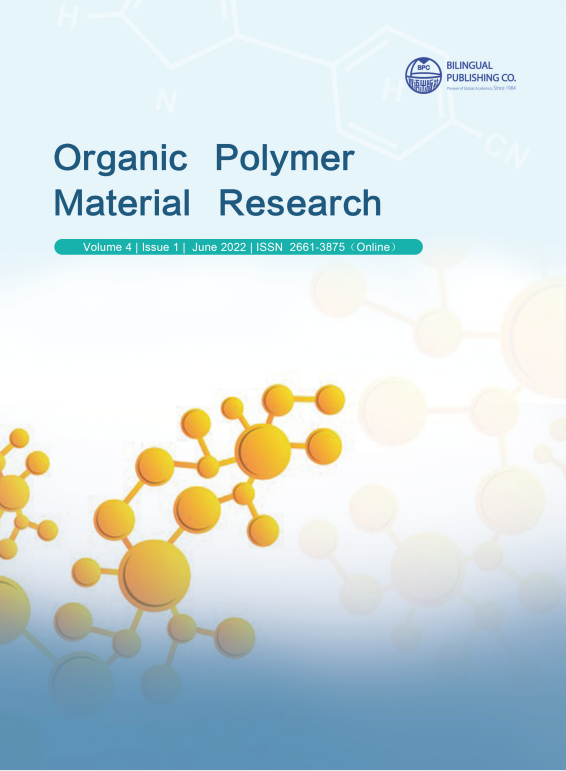-
240
-
156
-
149
-
133
-
118
Study of Structural Characteristics of Cellulose Esters with Different Degrees of Substitution
DOI:
https://doi.org/10.30564/opmr.v4i1.4805Abstract
In this article, structural characteristics of amorphous mono-, di-, andtri-substituted esters of cellulose have been studied. These esters weresynthesized under homogenous conditions using anhydrides of variousaliphatic acids. The specific gravity of the highly substituted samples wasmeasured by a pycnometric method in the aqueous medium. To calculatethe molar, Van der Waals, and free volumes, as well as the packingcoefficient of amorphous esters the method of additive contributions ofpartial volumes of atoms and atom groups in the volumes of polymerswas used. Based on the molar volume, also specific gravity of celluloseesters was calculated. The coincidence of calculated and experimentalcharacteristics was shown. In addition, the relationship between glasstransition temperature and free volume was found for the esters. Thetheoretical equations were derived, which provide predicting the structuralcharacteristics of cellulose esters with different degrees of substitution.Keywords:
Esters of cellulose; Substitution degree; Structural characteristics; Study; CalculationsReferences
[1] Wei, D.W., Wei, H., Gauthier, A.C., et al., 2020. Superhydrophobic modification of cellulose and cotton textiles: Methodologies and applications. Journal Bioresources and Bioproducts. 5, 1-15.
[2] Ioelovich, M., 2021. Adjustment of hydrophobic properties of cellulose materials. Polymers. 13, 1241.
[3] Freire, C.S.R., Silvestre, A.J.D., Neto, C.P., et al., 2005. An efficient method for determination of the degree of substitution of cellulose esters of long chain aliphatic acids. Cellulose. 12, 449-458.
[4] Gocho, H., Shimizu, H., Tanioka, A., et al., 2000. Effect of acetyl content on the sorption isotherm of water by cellulose acetate: comparison with the thermal analysis results. Carbohydrate Polymers. 41, 83-86.
[5] Khoshtinat, S., Carvelli, V., Marano, C., 2021. Moisture absorption measurement and modeling of cellulose acetate. Cellulose. 28, 9039-9050.
[6] Del Gaudio, I., Hunter-Sellars, E., Parkin, I., et al., 2021. Water sorption and diffusion in cellulose acetate: the effect of plasticizers. Carbohydrate Polymers. 267, 118185.
[7] Chalykh, A.E., Bardyshev, I.I., Petrova, T.F., 2021. Free volume and water sorption by cellulose esters. Polymers. 13, 2644.
[8] Ioelovich, M., 2022. Study of water vapor sorption by cellulose esters with different degrees of substitution. World Journal of Advanced Research and Review. 15(1), 214-220.
[9] Edgar, K.J., Buchanan, C.M., Debenham, J.S., et al., 2001. Advances in cellulose ester performance and application. Progress in Polymer Science. 26, 1605- 1688.
[10] Filho, G.R., Monteiro, D.S., Da Silva Meireles, K., et al., 2008. Synthesis and characterization of cellulose acetate produced from recycled newspaper. Carbohydrate Polymers. 73, 74-82.
[11] Fischer, S., Thümmler, K., Volkert, B., et al., 2008. Properties and applications of cellulose acetate. Macromolecular Symposia. 262, 89-96.
[12] Sassy, J.F., Chanzy, H., 1995. Ultrastructural aspects of the acetylation of cellulose. Cellulose. 2, 111-127.
[13] ASTM D792-20 Standard, 2020. Test Methods for Density and Specific Gravity (Relative Density) of Plastics by Displacement.
[14] Duncan, J.C., Price, D.M., 2016. Thermomechanical, Dynamic Mechanical and Dielectric Methods. Principles of Thermal Analysis and Calorimetry, 2nd Edition. Simon Gaisford, Vicky Kett and Peter Haines Eds. Royal Soc.: Cambridge. pp. 265.
[15] Van Krevelen, D.W., Nijenhuis, K., 2009. Properties of Polymers: Correlations with Chemical Structure. Elsevier: Amsterdam. pp. 1004.
[16] Ioelovich, M., Laka, M., 2002. Mesomorphous structure of amorphized cellulose esters. Scientific Israel Technological Advantages. 4, 87-89.
[17] Ioelovich, M., 2022. Study of structural characteristics of cellulose esters. Global Journal of Engineering and Technology Advance. 11(3), 24-30.
[18] Askadsky, A.A., 1995. Quantitative analysis of the influence of chemical structure on the physical properties of polymers. Polymer Science Series B. 37, 332-357.
[19] White, R.P., Lipson, J.E., 2016. Polymer free volume and its connection to the glass transition. Macromolecules. 49, 3987-4007.
[20] Ioelovich, M., 2016. Models of supramolecular structure and properties of cellulose. Polymer Science Series A. 58, 925-943.




 Michael Ioelovich
Michael Ioelovich





